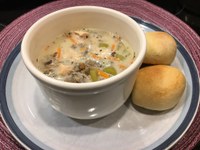Prairie Fare: Watch Your Sodium Intake During American Heart Month
(Click an image below to view a high-resolution image that can be downloaded)
By Julie Garden-Robinson, Food and Nutrition Specialist
NDSU Extension
“What should I make for dinner?” I asked my older daughter when we were at the grocery store on a very cold February day.
“Let’s have wild rice soup,” she said.
“OK, I will find a recipe to try,” I noted.
I pulled out my phone and began checking some recipe sites for a soup recipe to adapt.
“No, I want the kind in a package,” she said.
“That’s high in sodium,” my husband chimed in as he glanced in my direction.
He’s definitely right about the sodium values in many processed foods. We might think we are improving our sodium level by leaving the salt shaker in the cupboard. However, Americans consume 75 percent of their sodium from processed foods, not from table salt.
In fact, some commercial soups have 35 to 50 percent of the total daily value for sodium in one cup.
Yes, we have used the “packaged” soup, but we usually dilute the sodium by adding lots of fresh vegetables.
“Well, let’s just have chili instead,” my daughter noted.
I guess she wasn’t trusting that I would come up with a tasty homemade wild rice soup recipe.
I exercised my parental veto power because I had found a couple of wild rice soup recipes to combine to meet the unique tastes of my family.
Wild rice is a food I grew up with as a side dish usually served on holidays. Wild rice is not actually “rice.” Wild rice is the seed of a grass grown in water, and it has a chewier texture, unique flavor and, usually, a higher price tag.
Wild rice differs nutritionally from white rice in a positive way. For example, a cup of cooked wild rice has 166 calories, 6 1/2 grams of protein and 3 grams of fiber. A cup of cooked white rice has 205 calories, 4 grams of protein and less than 1 gram of fiber.
Unless we add salt, neither white rice nor wild rice contains sodium to any extent.
Why is sodium a nutrient of concern, anyway?
When we eat too much sodium, our body retains more water to maintain the proper fluid balance, which can raise our blood pressure. Hypertension puts an extra burden on our heart and blood vessels, which can cause damage throughout the body.
Read the labels when you buy prepared and packaged foods, and watch for the words “soda” (referring to sodium bicarbonate, or baking soda) and “sodium.” These products contain sodium compounds. Sea salt and kosher salt also are forms of sodium chloride.
Consider reducing the sodium in your diet by choosing foods that are naturally low in sodium, such as fresh or frozen fruits and vegetables without sauces.
To reduce sodium, limit processed foods such as ham or frozen dinners and restaurant-prepared foods. Prepare homemade meals because you have the most control of how much sodium gets added. When you are in a grocery store, opt for “low in sodium” or “reduced sodium” products.
Like many things in life, salt is an acquired taste. We build up a tolerance for it and we “expect” it in the foods we eat. If you gradually reduce the sodium in your diet, you’ll slowly adjust to the less salty flavor. Experiment with new recipes that rely on herbs and spices instead of salt.
Visit https://www.ag.ndsu.edu/nourishyourbody for more information about taking care of your heart and the rest of your body. The site has online modules, handouts, recipes and links to reputable websites.
Here’s a comfort food recipe that my family enjoyed on a cold, blustery February day. My daughter liked it, by the way.
Homestyle Vegetable-Wild Rice Soup
1 1/2 c. raw wild rice, cooked according to package directions
3 Tbsp. oil, such as canola, sunflower or olive
2 c. onion, diced
2 c. celery, diced
2 c. carrots, cut into matchsticks
8 ounces mushrooms, sliced (about 3 c.)
2 tsp. garlic, minced
2/3 c. all-purpose flour
4 (15-ounce) cans chicken broth, reduced-sodium
1 tsp. dried thyme
3/4 tsp. dried rosemary
1/2 tsp. dried oregano
1/2 to 1 tsp. salt (or less, to taste)
1 tsp. pepper (or to taste)
1 1/2 pounds chicken, cooked and cut into bite-sized pieces
1 c. half and half
Cook wild rice in boiling water according to package instructions.
Note: The wild rice cooking process may take 45 minutes or more. This step may be done in advance, with the rice refrigerated until preparation time. Alternatively, substitute 3 c. canned wild rice to cut preparation time. For the chicken, you can use grilled or leftover precooked chicken.
Heat oil in a large stockpot. Add onion, celery, carrots, mushrooms and garlic, and saute until tender. Sprinkle flour over vegetables and cook for two minutes. Add chicken broth and spices. Heat to simmer and cook until thickened. Stir in cooked chicken and cooked wild rice and simmer. About five minutes before serving, stir in half and half.
Makes 10 servings. Without added salt, each serving has 310 calories, 9 grams (g) fat, 24 g protein, 33 g carbohydrate, 4 g fiber and 480 milligrams sodium.
(Julie Garden-Robinson, Ph.D., R.D., L.R.D., is a North Dakota State University Extension food and nutrition specialist and professor in the Department of Health, Nutrition and Exercise Sciences. Follow her on Twitter @jgardenrobinson)
NDSU Agriculture Communication - Feb. 6, 2019
| Source: | Julie Garden-Robinson, 701-231-7187, julie.garden-robinson@ndsu.edu |
|---|---|
| Editor: | Ellen Crawford, 701-231-5391, ellen.crawford@ndsu.edu |



